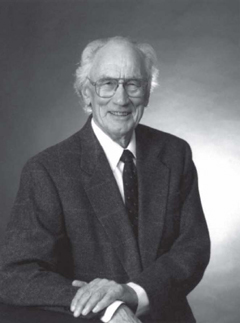Kenneth Lee Pike facts for kids
Quick facts for kids
Kenneth Lee Pike
|
|
|---|---|
 |
|
| Born | June 9, 1912 |
| Died | December 31, 2000 (aged 88) |
| Nationality | American |
| Alma mater | Gordon College and University of Michigan |
| Known for | Tagmemics Emic and etic |
| Scientific career | |
| Doctoral advisor | Charles C. Fries |
Kenneth Lee Pike (June 9, 1912 – December 31, 2000) was an American linguist and anthropologist. A linguist studies human language. An anthropologist studies human societies and cultures.
Pike created a theory called tagmemics. He also invented the terms "emic" and "etic". These words are used to describe different ways of looking at cultures and languages. He even made a special language called Kalaba-X. This language was used to teach people about how to translate.
Pike was also the first president of the Bible-translating group. This group is called the Summer Institute of Linguistics (SIL). He worked with SIL from 1935 until he passed away.
Contents
Kenneth Pike's Life Story
Pike was born in Woodstock, Connecticut, in 1912. He studied theology at Gordon College. Theology is the study of religious beliefs. He earned a bachelor's degree in 1933.
He first wanted to be a missionary in China. But he was not able to go there. So, he decided to study linguistics instead. He learned about language at the Summer Institute of Linguistics (SIL). In 1935, he went to Mexico with SIL. There, he learned the Mixtec language from people who spoke it.
Studying and Working
In 1937, Pike went to the University of Michigan. He worked on his advanced degree, called a doctorate, in linguistics. His teacher was Charles C. Fries. For his research, Pike lived among the Mixtec people. He and his wife, Evelyn, created a written system for the Mixtec language.
Pike earned his Ph.D. in 1942. After that, he became the first president of the Summer Institute of Linguistics. The main goal of SIL was to translate the Bible into languages that did not have a written form. In 1951, Pike published the Mixtec New Testament. He was the president of SIL International from 1942 to 1979.
Pike also worked at the University of Michigan for 30 years. He was the chairman of the linguistics department. He was also a professor of linguistics. He directed the English Language Institute. He helped create new ways to teach the English language. Later, he became a Professor Emeritus at the university. This means he was a retired professor who kept his title.
Pike's Important Work
Pike is most famous for his ideas about "emic" and "etic" viewpoints. These terms help us understand different ways of looking at things.
- Emic (like in "phonemics") means understanding something from inside a culture or language system. It's how people who are part of that system see it. Pike believed that only native speakers could truly judge emic descriptions. They are very important for gathering language information.
- Etic (like in "phonetics") means studying something from outside the system. It's like a scientist looking at a language. Outside researchers use scientific methods to study language. This creates etic descriptions that can be checked and repeated.
Pike traveled a lot to study different languages. He worked with native languages in many countries. These included Australia, Bolivia, Ecuador, Ghana, Java, Mexico, Nepal, New Guinea, Nigeria, the Philippines, and Peru.
Tagmemics and Language Study
Pike also developed his theory of tagmemics. This theory helped analyze languages from Central and South America. It looked at parts of language (like words or sounds). It identified how these parts could play different roles in a sentence. This involved both their meaning (semantic) and their structure (syntactic).
Pike had a different way of studying language than Noam Chomsky. Chomsky was a very important linguist in the 20th century. Pike believed that language should be studied in its full context. This means looking at how language is used in real life, not just as single sentences. His most important book was called Language in Relation to a Unified Theory of the Structure of Human Behavior (1967).
Monolingual Demonstrations
Pike was also known for his "monolingual demonstrations." He would stand in front of an audience. He would have many chalkboards ready. Then, a speaker of a language he didn't know would join him. Pike would use gestures and objects. He would not ask questions in any language the person might know. He would then start to analyze the unknown language right there for everyone to see.
Awards and Recognition
Pike was a member of many important groups. These included the National Academy of Sciences. He was also part of the Linguistic Society of America (LSA). He was even president of the LSA and the Linguistic Association of Canada and the United States (LACUS). He was also a member of the American Anthropological Association.
He was nominated for the Templeton Prize three years in a row. This prize honors people who make progress in spiritual matters.
In 1974, he was given a special professorship at the University of Michigan. It was called the Charles Carpenter Fries Professorship of Linguistics. The university leaders said his "lifelong originality and energetic activity verge on the legendary." This means his work was amazing and almost like a legend.
Pike received honorary degrees from many universities. These included the University of Chicago and Georgetown University. In 1983, two US politicians, Senator Alan J. Dixon and Congressman Paul Simon, announced something special. They had nominated Pike for the Nobel Peace Prize. Many important scholars supported his nomination.
See also
 In Spanish: Kenneth Pike para niños
In Spanish: Kenneth Pike para niños
- Americanist phonetic notation#Pike
- Wycliffe Global Alliance

